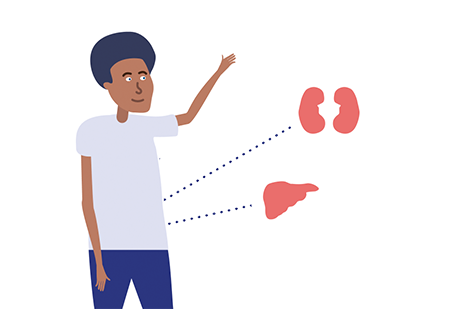
You can donate a kidney, a piece of your liver, and certain other organs and tissues while alive. About 6,500 living donation transplants take place each year.
Unlike deceased donors, a living donor can decide who to donate their organ to, helping a recipient get an organ transplant faster. Most living donations happen between family members or close friends. Other people choose to donate to someone they don't know. See stories of real people who have donated and received organs.
Living donation is typically safe for the donor. Most living donors go on to live active, healthy lives and can see the positive impact of their donation.

While alive, you can donate one kidney , part of your liver , and certain other organs and tissues.
85% of people on the organ transplant waiting list need a kidney .

Kidneys are the organs most frequently needed, followed by livers. Both of these organs can be donated by living donors to save someone’s life.
You may be able to donate:
You may be able to donate:
You can donate blood or bone marrow more than once. The body replaces them after you donate.
Parents, husbands, wives, friends, co-workers—even total strangers—can be living donor candidates.
To be a living donor, you must:
Both you and the transplant hospital staff will need to decide whether living donation is right for you. Hospital staff will gather a lot of information about you to determine if you are healthy enough to donate an organ.
You can expect to:
If tests show that you are not compatible with the person in need of an organ transplant, you may have other options to donate, such as kidney paired donation.
Donation procedure: what to expectFor more information about the living donation process, visit the Organ Procurement and Transplantation Network's living donation page.
Potential risks of living donationTransplant centers follow-up with living donors after the transplant. They report, on average, living donors do well over the long term.
As with most medical procedures, there are possible risks for living organ donation surgery. These risks differ depending on each individual donor as well as the type of organ donated. Short-term effects may include pain or infection from the procedure. Long-term effects can include hypertension for kidney donors, or intestinal problems for liver donors.
As more research emerges on the impact of donation on living donors, the more we can fully understand the risks and benefits to living donors.
It can be very rewarding to help another person. You can donate an organ to someone you know (directed donation) or to someone you don’t know (non-directed donation). If you wish to help someone through directed donation but you are not a match, kidney paired donation may be an option.
Kidney paired donation allows for two or more incompatible donor/recipient pairs to swap donors. The donors are then able to give their kidney to a compatible recipient in a different pair. By exchanging donors, a compatible match can be found for these recipients.

The National Living Donor Assistance Center (NLDAC) provides financial help to living donors.
They may be able to help you with:
You can learn more by contacting the patient services department of the Organ Procurement and Transplantation Network (OPTN) at 1-888-894-6361 or email Patient.Services@unos.org.
If you would like to help someone you know through living directed donation, talk to them and contact the transplant program where the person is listed. If you would like to help someone you do not know by being a living non-directed donor, contact a transplant hospital of your choice and ask if they have such a donation program. Go to the OPTN Member Directory for a list of transplant hospitals.

View or download English and Spanish educational materials on living organ donation, including videos, an infographic, social media graphics, and fact sheets for potential donors and recipients.